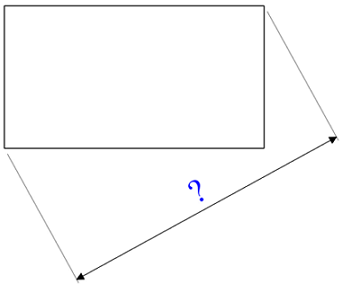Can We Can Calculate Its Diagonal?

A rectangle has perimeter and area, 3 2 m and 5 6 m 2 respectively. Find the length of its diagonal?
This section requires Javascript.
You are seeing this because something didn't load right. We suggest you, (a) try
refreshing the page, (b) enabling javascript if it is disabled on your browser and,
finally, (c)
loading the
non-javascript version of this page
. We're sorry about the hassle.
2 solutions
did the exact same thing
Great Solution!!!
So what are the values of l and b such that 2l + 2b = 32 while l*b = 56, went through the factors of 56 and none them work.
Log in to reply
We can get the ans by solving the following quadratics eq. X^2-16x+56=0 Here 16= half of the perimeter and 56= area .answer= lenght=10.8285 and breath =5.1715 .
Log in to reply
Yes, they use the factors (8 + sqrt8) and (8- sqrt8) difference of squares 64-8 = 56. Now it makes sense.
In response to Yash Jagani. I see that solving this quadratic gives the solution, but I can't work it backwards. Could you please show me how you got this equation from the given information? ie how do you know the 16 and 56 go here? Thanks!
Log in to reply
@Jim Addams – It is given that: { 2 l + 2 b = 3 2 ⟹ l + b = 1 6 l b = 5 6 Isolate one of the variables from any one of the equations: Let's isolate l from the first equation. We get: l = 1 6 − b Substitute the value of l from the first equation into the second equation. We get: l b ( 1 6 − b ) b 1 6 b − b 2 − b 2 + 1 6 b − 5 6 ( − 1 ) × ( − b 2 + 1 6 b − 5 6 ) b 2 − 1 6 b + 5 6 = 5 6 = 5 6 = 5 6 = 0 = ( − 1 ) × 0 = 0
LET a be the length and b be the breadth. perimeter is 32 i.e 2(a+b)=32 area is 56 i.e a b=56 now we know a+b is 16 square both sides a^2 + b^+ 2ab =256 a^2 +b^2 = 256-2 56=144 therfore length of diagonal is square root of a^2 +b^2 i.e 12..
Let ′ l ′ and ′ b ′ be the length and breadth of the rectangle.
perimeter = 2 × ( l + b ) = 32.
⇒ l + b = 1 6 → ( 1 ) Also, we have area = l × b = 5 6 . squaring both the sides of eq (1) we get, ( l + b ) 2 = 2 5 6 .
l 2 + b 2 + 2 a b = 2 5 6 . ⇒ l 2 + b 2 + 2 × 5 6 = 2 5 6 .
⇒ l 2 + b 2 = 2 5 6 − 1 1 2 = 1 4 4 . l 2 + b 2 = 1 2 = diagonal of the rectangle. ( By Pythagorean theorem )